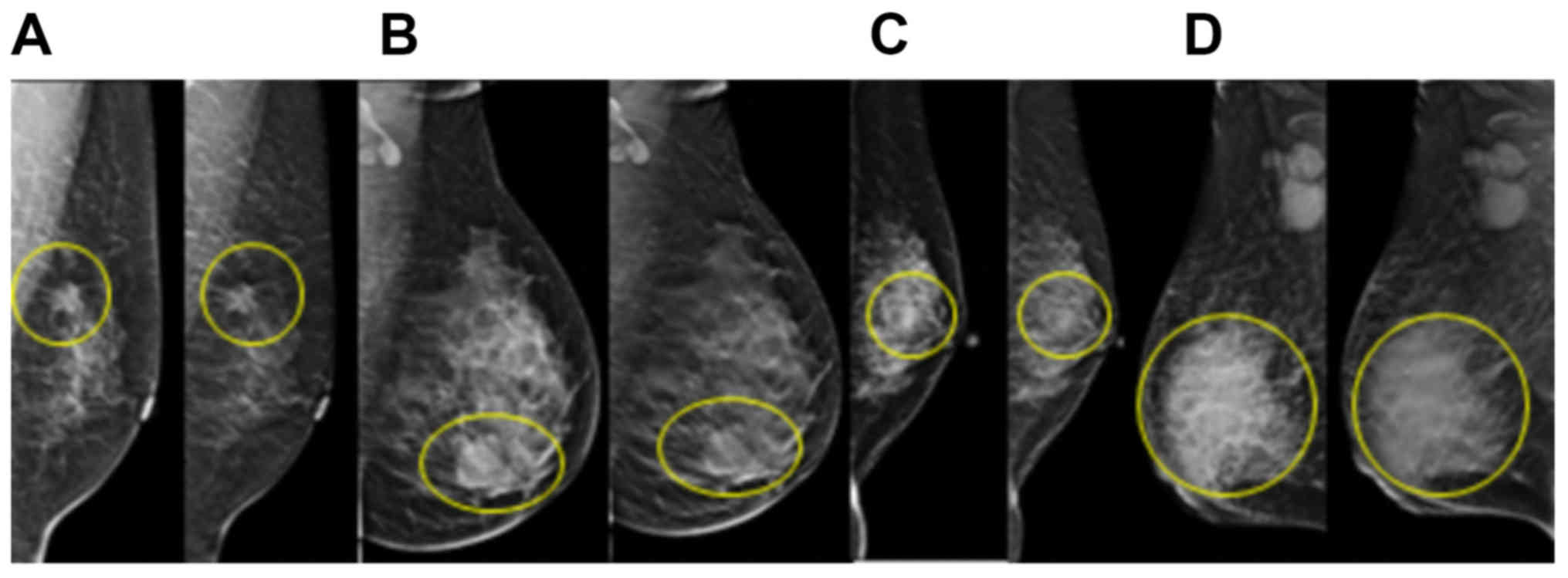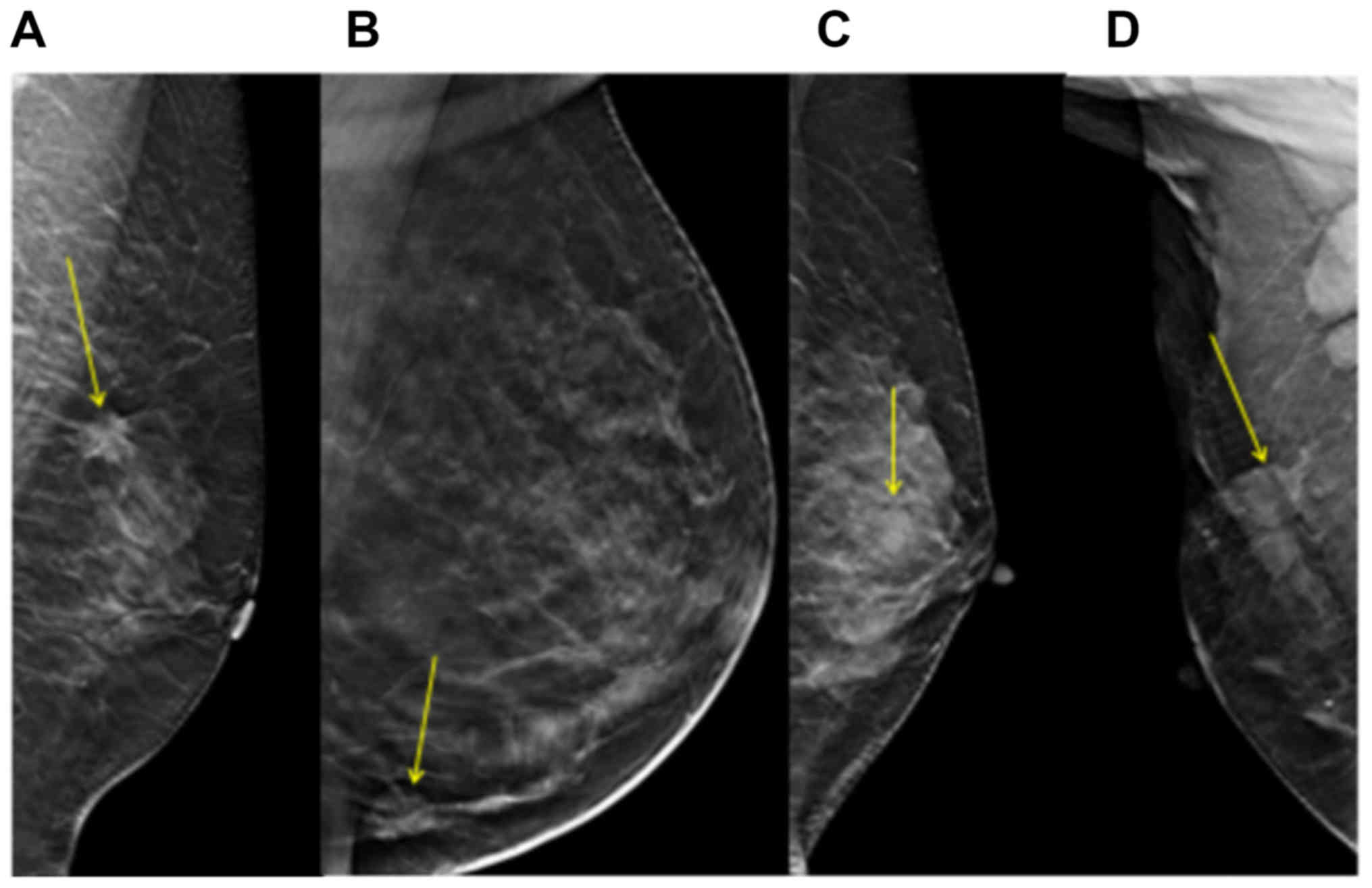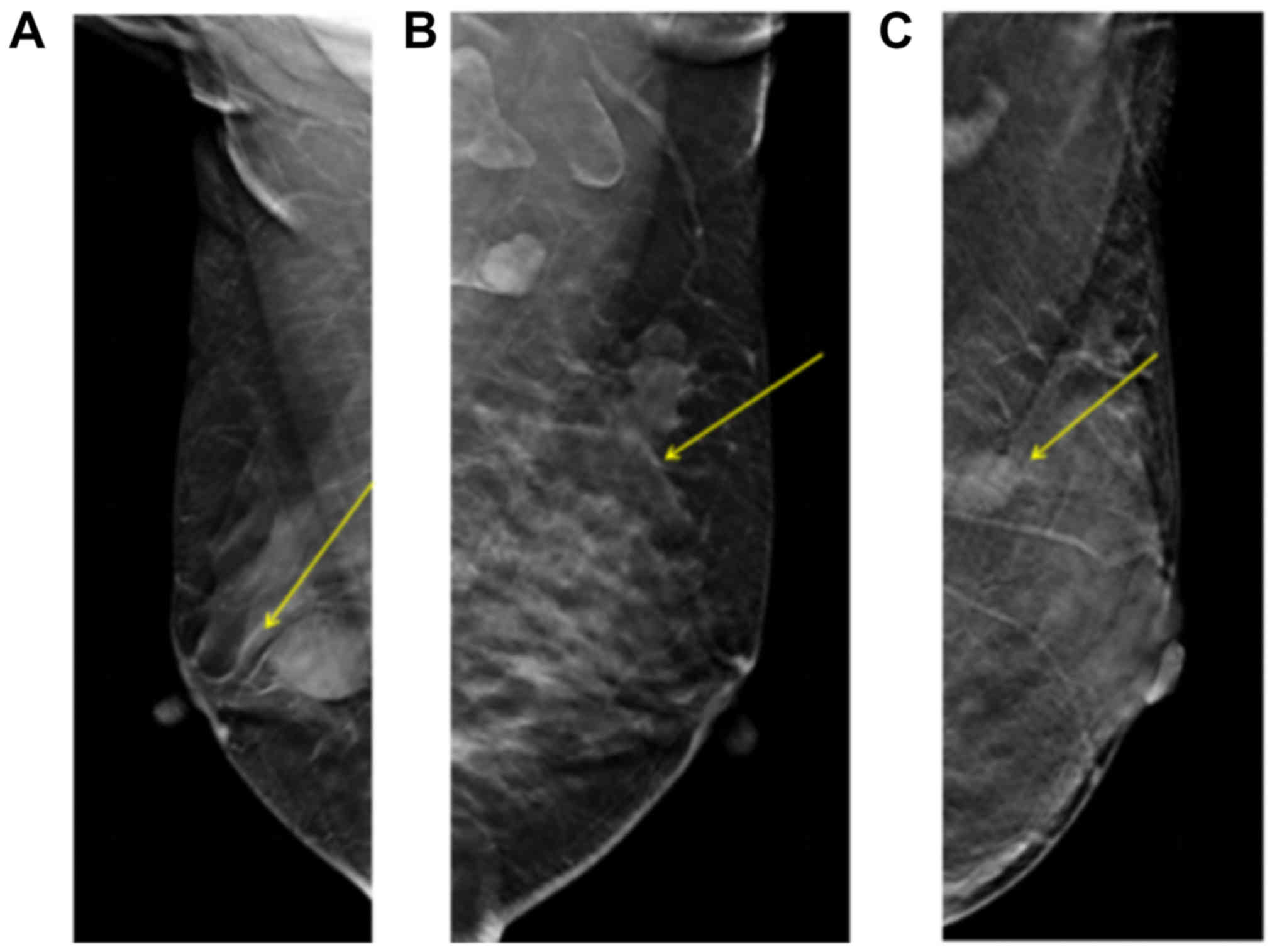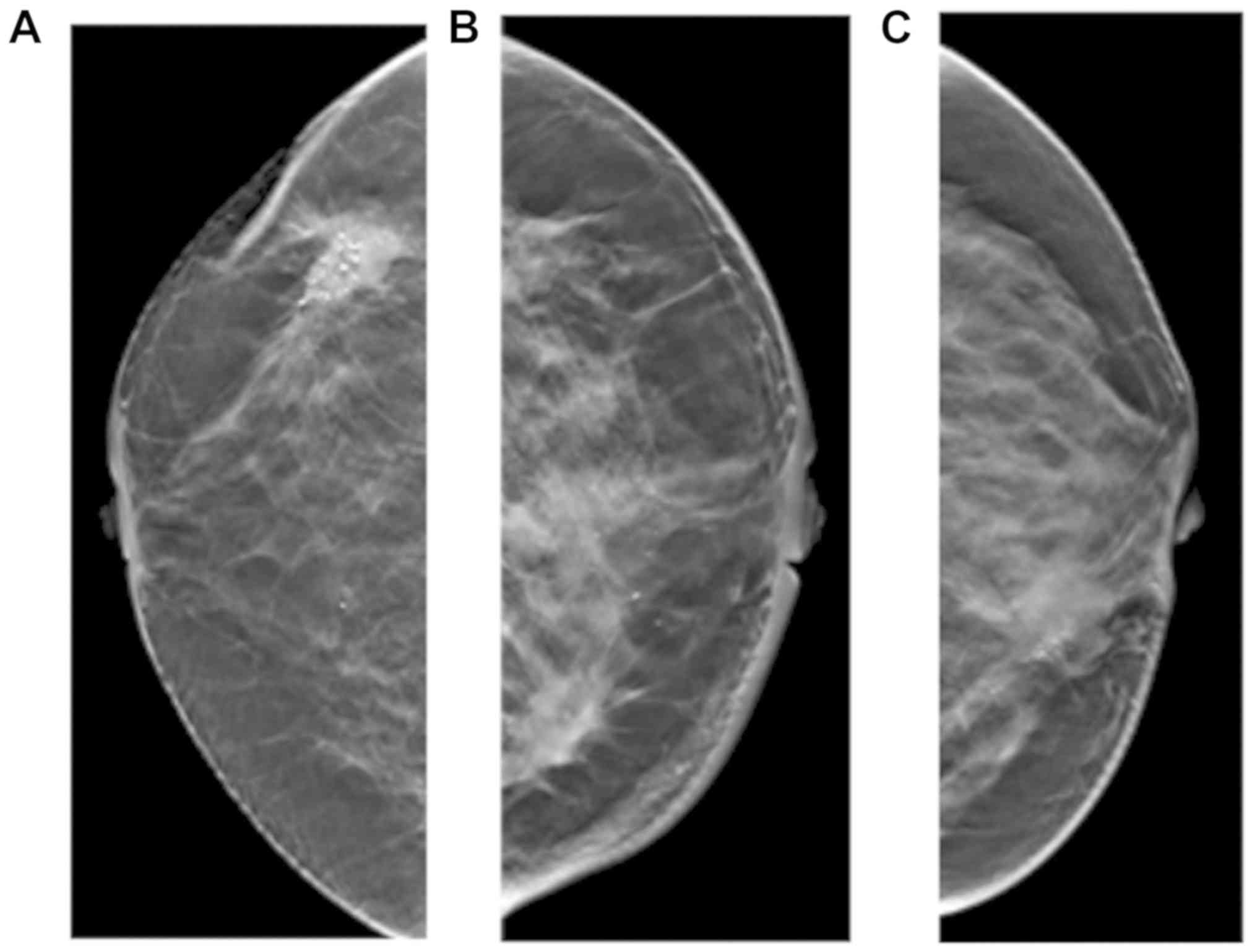|
1
|
Hortobagyi GN, de la Garza Salazar J,
Pritchard K, Amadori D, Haidinger R, Hudis CA, Khaled H, Liu MC,
Martin M, Namer M, et al: The global breast cancer burden:
Variations in epidemiology and survival. Clin Breast Cancer.
6:391–401. 2005. View Article : Google Scholar : PubMed/NCBI
|
|
2
|
Tao Z, Shi A, Lu C, Song T, Zhang Z and
Zhao J: Breast cancer: Epidemiology and etiology. Cell Biochem
Biophys. 72:333–338. 2015. View Article : Google Scholar : PubMed/NCBI
|
|
3
|
Perou CM, Sørlie T, Eisen MB, van de Rijn
M, Jeffrey SS, Rees CA, Pollack JR, Ross DT, Johnsen H, Akslen LA,
et al: Molecular portraits of human breast tumours. Nature.
406:747–752. 2000. View
Article : Google Scholar : PubMed/NCBI
|
|
4
|
Sørlie T, Perou CM, Tibshirani R, Aas T,
Geisler S, Johnsen H, Hastie T, Eisen MB, van de Rijn M, Jeffrey
SS, et al: Gene expression patterns of breast carcinomas
distinguish tumor subclasses with clinical implications. Proc Natl
Acad Sci USA. 98:10869–10874. 2001. View Article : Google Scholar : PubMed/NCBI
|
|
5
|
Carey LA, Perou CM, Livasy CA, Dressler
LG, Cowan D, Conway K, Karaca G, Troester MA, Tse CK, Edmiston S,
et al: Race, breast cancer subtypes, and survival in the Carolina
breast cancer study. JAMA. 295:2492–2502. 2006. View Article : Google Scholar : PubMed/NCBI
|
|
6
|
Li X, Huang Y, Shuqin Z, Chen Z and Zhang
S: Re: Association between imaging characteristics and different
molecular subtypes of breast cancer. Acad Radiol. 24:11842017.
View Article : Google Scholar : PubMed/NCBI
|
|
7
|
Eroles P, Bosch A, Pérez-Fidalgo JA and
Lluch A: Molecular biology in breast cancer: Intrinsic subtypes and
signaling pathways. Cancer Treat Rev. 38:698–707. 2012. View Article : Google Scholar : PubMed/NCBI
|
|
8
|
Liedtke C and Kiesel L: Breast cancer
molecular subtypes-modern therapeutic concepts for targeted therapy
of a heterogeneous entity. Maturitas. 73:288–294. 2012. View Article : Google Scholar : PubMed/NCBI
|
|
9
|
Di Gioia D, Stieber P, Schmidt GP, Nagel
D, Heinemann V and Baur-Melnyk A: Early detection of metastatic
disease in asymptomatic breast cancer patients with whole-body
imaging and defined tumour marker increase. Br J Cancer.
112:809–818. 2015. View Article : Google Scholar : PubMed/NCBI
|
|
10
|
Zelig U, Barlev E, Bar O, Gross I, Flomen
F, Mordechai S, Kapelushnik J, Nathan I, Kashtan H, Wasserberg N
and Madhala-Givon O: Early detection of breast cancer using total
biochemical analysis of peripheral blood components: A preliminary
study. BMC Cancer. 15:4082015. View Article : Google Scholar : PubMed/NCBI
|
|
11
|
Rao M, Stough J, Chi YY, Muller K, Tracton
G, Pizer SM and Chaney EL: Comparison of human and automatic
segmentations of kidneys from CT images. Int J Radiat Oncol Biol
Phys. 61:954–960. 2005. View Article : Google Scholar : PubMed/NCBI
|
|
12
|
Takamoto Y, Tsunoda H, Kikuchi M, Hayashi
N, Honda S, Koyama T, Ohde S, Yagata H, Yoshida A and Yamauchi H:
Role of breast tomosynthesis in diagnosis of breast cancer for
Japanese women. Asian Pac J Cancer Prev. 14:3037–3040. 2013.
View Article : Google Scholar : PubMed/NCBI
|
|
13
|
Roth RG, Maidment AD, Weinstein SP, Roth
SO and Conant EF: Digital breast tomosynthesis: Lessons learned
from early clinical implementation. Radiographics. 34:E89–E102.
2014. View Article : Google Scholar : PubMed/NCBI
|
|
14
|
Tang W, Li R, Gao Y, Wang Q, Shen Q, Gu Y
and Peng W: A comparative study of diagnostic performance between
digital breast tomosynthesis and conventional imaging methods.
China Oncol. 27:487–495. 2017.
|
|
15
|
Mariscotti G, Houssami N, Durando M,
Campanino PP, Regini E, Fornari A, Bussone R, Castellano I, Sapino
A, Fonio P and Gandini G: Digital breast tomosynthesis (DBT) to
characterize MRI-detected additional lesions unidentified at
targeted ultrasound in newly diagnosed breast cancer patients. Eur
Radiol. 25:2673–2681. 2015. View Article : Google Scholar : PubMed/NCBI
|
|
16
|
Cai SQ, Yan JX, Chen QS, Huang ML and Cai
DL: Significance and application of digital breast tomosynthesis
for the BI-RADS classification of breast cancer. Asian Pac J Cancer
Prev. 16:4109–4114. 2015. View Article : Google Scholar : PubMed/NCBI
|
|
17
|
Wiechmann L, Sampson M, Stempel M, Jacks
LM, Patil SM, King T and Morrow M: Presenting features of breast
cancer differ by molecular subtype. Ann Surg Oncol. 16:2705–2710.
2009. View Article : Google Scholar : PubMed/NCBI
|
|
18
|
Cen D, Xu L, Li N, Chen Z, Wang L, Zhou S,
Xu B, Liu Cl, Liu Z and Luo T: BI-RADS 3–5 microcalcifications can
preoperatively predict breast cancer HER2 and Luminal a molecular
subtype. Oncotarget. 8:13855–13862. 2017. View Article : Google Scholar : PubMed/NCBI
|
|
19
|
Pan B, Yao R, Zhou YD, Zhu QL, Shi J, Xu
QQ, Wang CJ, You SS, Mao F, Lin Y, et al: Tumor biology,
clinicopathological characteristics and prognosis of screen
detected T1 invasive non-palpable breast cancer in asymptomatic
Chinese women (2001–2014). Oncotarget. 8:26221–26230.
2017.PubMed/NCBI
|
|
20
|
Partyka L, Lourenco AP and Mainiero MB:
Detection of mammographically occult architectural distortion on
digital breast tomosynthesis screening: Initial clinical
experience. AJR Am J Roentgenol. 203:216–222. 2014. View Article : Google Scholar : PubMed/NCBI
|
|
21
|
Sickles EA, D'Orsi CJ, Bassett LW, et al:
ACR BI-RADS®Mammography. In: ACR
BI-RADS®Atlas, Breast Imaging Report and Date System.
American College of Radiology; Reston, VA: pp. 15–75. 2013
|
|
22
|
Wang W, Bai YH, Deng YM, et al:
Stsage-specific Survival Analysis according to the 2002 American
Joint Committee on breast cancer staging system. Pract J Cancer.
22:286–289. 2007.(in Chinese).
|
|
23
|
Lu J, Ni C and Wu D: Breast benign and
malignant calcification score and clinical application. Chin J Med
Imaging. 385–387. 2008.
|
|
24
|
Shaolin L, Jun L, Licong F, Peikun Z and
Han L: Correlation between size and metastasis of mediastinal lymph
nodes in lung cancer by CT examination. Qilu Tumor J. 75:1998.
|
|
25
|
Goldhirsch A, Winer EP, Coates AS, Gelber
RD, Piccart-Gebhart M, Thürlimann B and Senn HJ; Panel Members:
Personalizing the treatment of women with early breast cancer:
Highlights of the St gallen international expert consensus on the
primary therapy of early breast cancer 2013. Ann Oncol.
24:2206–2223. 2013. View Article : Google Scholar : PubMed/NCBI
|
|
26
|
Kumar N, Patni P, Agarwal A, Khan MA and
Parashar N: Prevalence of molecular subtypes of invasive breast
cancer: A retrospective study. Med J Armed Forces India.
71:254–258. 2015. View Article : Google Scholar : PubMed/NCBI
|
|
27
|
Bennis S, Abbass F, Akasbi Y, Znati K,
Joutei KA, El Mesbahi O and Amarti A: Prevalence of molecular
subtypes and prognosis of invasive breast cancer in north-east of
Morocco: Retrospective study. BMC Res Notes. 5:4362012. View Article : Google Scholar : PubMed/NCBI
|
|
28
|
Yang WT and Tse GM: Sonographic,
mammographic, and histopathologic correlation of symptomatic ductal
carcinoma in situ. AJR Am J Roentgenol. 182:101–110. 2004.
View Article : Google Scholar : PubMed/NCBI
|
|
29
|
Ko ES, Lee BH, Kim HA, Noh WC, Kim MS and
Lee SA: Triple-negative breast cancer: Correlation between imaging
and pathological findings. Eur Radiol. 20:1111–1117. 2010.
View Article : Google Scholar : PubMed/NCBI
|
|
30
|
Kim SH, Seo BK, Lee J, Kim SJ, Cho KR, Lee
KY, Je BK, Kim HY, Kim YS and Lee JH: Correlation of ultrasound
findings with histology, tumor grade, and biological markers in
breast cancer. Acta Oncol. 47:1531–1538. 2008. View Article : Google Scholar : PubMed/NCBI
|
|
31
|
Demircioglu F, Demirci U, Kilic D, Ozkan S
and Karahacioglu E: Clinical significance of lymph node ratio in
locally advanced breast cancer molecular subtypes. Onkologie.
36:637–640. 2013. View Article : Google Scholar : PubMed/NCBI
|













